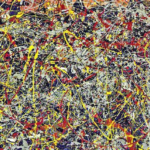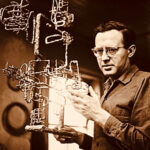First Generation Artists
The Emergence of Abstract Expressionism
Following the turmoil of World War II, the world grappled with feelings of disillusionment, uncertainty, and existential angst. In this climate, a group of American artists began to search for new ways to express their emotions and inner turmoil. Influenced by European modernists such as Wassily Kandinsky, Joan Miró, and the Surrealists, as well as the psychoanalytic theories of Carl Jung, these artists aimed to tap into the unconscious mind and convey pure emotion through their work.
New York City, with its vibrant cultural scene and influx of European intellectuals fleeing war-torn Europe, became the epicenter of this artistic revolution. The city’s dynamic environment fostered a sense of experimentation and innovation, leading to the birth of Abstract Expressionism.

The Top 40 First Generation Abstract Expressionists
1. Jackson Pollock
Jackson Pollock is arguably the most famous figure of Abstract Expressionism. His “drip” painting technique, where he splattered, poured, and dripped paint onto canvases laid on the floor, redefined artistic creation. Works like “No. 5, 1948” capture the movement’s essence of spontaneity and intense emotion.
2. Willem de Kooning
Willem de Kooning’s aggressive brushstrokes and abstracted forms, particularly in his “Women” series, blend figuration with abstraction. His powerful and energetic style solidified his place as a central figure in the movement.
3. Mark Rothko
Mark Rothko’s serene and meditative color field paintings, with large blocks of color that seem to float and interact, evoke deep emotional and spiritual responses. Pieces like “Orange and Yellow” (1956) highlight his quest for profound human experience.
4. Franz Kline
Franz Kline’s dramatic black-and-white compositions, characterized by sweeping, gestural brushstrokes, convey a sense of urgency and power. His work, such as “Chief” (1950), exemplifies the expressive potential of simplicity.
5. Lee Krasner
Lee Krasner, an accomplished artist and Jackson Pollock’s wife, evolved through various styles from biomorphic forms to intricate collages. Her vibrant and dynamic pieces, like “The Seasons” (1957), reflect her deep engagement with nature and creativity.
6. Robert Motherwell
Robert Motherwell brought a philosophical and literary dimension to Abstract Expressionism. His “Elegy to the Spanish Republic” series, with ovoid shapes and vertical bars, explores themes of loss and human suffering, blending abstraction with narrative and symbolism.
7. Barnett Newman
Barnett Newman’s “zip” paintings feature vertical stripes that divide the canvas, creating a sense of space and spirituality. Works like “Vir Heroicus Sublimis” (1950-51) exemplify his pursuit of the sublime.
8. Clyfford Still
Clyfford Still’s bold and monumental canvases, filled with jagged, abstract forms and vibrant colors, are deeply personal and emotionally charged. His work, such as “1957-D No. 1” (1957), stands out for its raw intensity and dramatic contrasts.
9. Adolph Gottlieb
Adolph Gottlieb’s paintings combine abstract forms with symbolic imagery. His “Burst” series, featuring explosive shapes set against monochromatic backgrounds, bridges the gap between abstraction and symbolism, conveying a sense of cosmic energy.
10. Arshile Gorky
Arshile Gorky’s abstract works, influenced by his traumatic past and Armenian heritage, blend organic forms with surrealist elements. Paintings like “The Liver is the Cock’s Comb” (1944) are rich with personal symbolism and emotional depth.
11. Hans Hofmann
Hans Hofmann, both a teacher and a painter, played a crucial role in shaping Abstract Expressionism. His work, known for vibrant colors and dynamic compositions, emphasizes the importance of color and form, as seen in “The Gate” (1959-60).
12. Philip Guston
Philip Guston’s early abstract works are marked by gestural brushstrokes and emotional intensity. Pieces like “Painting” (1954) reflect his deep engagement with abstract forms, though he later transitioned to a more figurative style.
13. Elaine de Kooning
Elaine de Kooning’s portraits and abstract works, characterized by loose, expressive brushwork and vibrant colors, capture the essence of her subjects. Her piece “Bullfight” (1959) showcases her dynamic approach to painting.
14. Richard Pousette-Dart
Richard Pousette-Dart’s intricate and spiritually symbolic abstract paintings often feature densely layered forms and luminous colors, creating a sense of depth and mystery. Works like “Symphony No. 1, The Transcendental” (1941-42) reflect his unique vision.
15. James Brooks
James Brooks’ lyrical abstraction and use of fluid forms create a sense of movement and harmony. His ability to balance spontaneity with control is evident in works like “Tangier” (1954).
16. Norman Lewis
Norman Lewis blended abstract forms with social commentary, often addressing themes of race and identity. His gestural brushstrokes and abstract shapes, as seen in “Phantasy II” (1946), create powerful and evocative images.
17. Hedda Sterne
Hedda Sterne’s work spans a wide range of styles, from surrealist-inspired pieces to abstract paintings. Her abstract works, featuring flowing lines and geometric shapes, create a sense of movement and depth, as seen in “New York, VIII” (1954).
18. Bradley Walker Tomlin
Bradley Walker Tomlin’s lyrical and gestural brushstrokes create a sense of harmony and balance. His abstract works, such as “Number 12-1949” (1949), convey emotion through delicate lines and organic shapes.
19. David Smith
David Smith, primarily a sculptor, brought Abstract Expressionism into three dimensions. His welded steel sculptures, like “Cubi XII” (1963), are characterized by their industrial materials and abstract forms, creating dynamic spatial compositions.
20. Theodoros Stamos
Theodoros Stamos’ abstract paintings often feature organic forms and vibrant colors. His work, influenced by nature and mythology, creates a sense of mystery and depth, as seen in pieces like “Infinity Field, Lefkada Series” (1980).
21. Jack Tworkov
Jack Tworkov’s abstract paintings are characterized by their gestural brushstrokes and dynamic compositions. His work, such as “Barrier” (1964), often explores themes of structure and space within the context of abstraction.
22. Milton Resnick
Milton Resnick’s heavily textured abstract paintings are known for their dense, layered surfaces. His work, such as “Swan” (1959), conveys a sense of depth and intensity through its rich, tactile quality.
23. William Baziotes
William Baziotes’ abstract paintings often incorporate biomorphic forms and mythological themes. His work, such as “The Dwarf” (1947), blends abstraction with symbolism, creating evocative and mysterious images.
24. George McNeil
George McNeil’s abstract paintings feature dynamic compositions and vibrant colors. His work, influenced by both Abstract Expressionism and later movements, creates a sense of rhythm and movement, as seen in pieces like “The Big Room” (1956).
25. David Hare
David Hare, known for his surrealist sculptures, also contributed to Abstract Expressionism through his dynamic and evocative three-dimensional works. His sculptures often feature organic and abstract forms, reflecting his interest in both nature and the subconscious.
26. Al Held
Al Held’s early abstract paintings are characterized by their bold colors and geometric shapes. His work often explores themes of space and structure, creating dynamic compositions that challenge traditional perspectives.
27. Seymour Lipton
Seymour Lipton, a prominent sculptor, created abstract works that often explored themes of human emotion and experience. His sculptures, such as “Guardian” (1954), are characterized by their intricate forms and use of industrial materials.
28. Conrad Marca-Relli
Conrad Marca-Relli’s collages and abstract paintings often feature bold shapes and dynamic compositions. His work, influenced by both Abstract Expressionism and Cubism, creates a sense of depth and movement through its use of layered forms and textures.
29. Esteban Vicente
Esteban Vicente’s abstract paintings are characterized by their vibrant colors and dynamic compositions. His work often explores themes of light and space, creating a sense of depth and movement through the use of color and form.
30. James Rosati
James Rosati’s abstract sculptures are known for their bold, geometric forms and dynamic compositions. His work often explores themes of space and structure, creating complex and engaging three-dimensional pieces.
31. Michael Corinne West
Michael Corinne West, one of the few female artists associated with Abstract Expressionism, created dynamic and vibrant abstract paintings. Her work often explores themes of emotion and the subconscious, using bold colors and gestural brushstrokes to convey her ideas.
32. Alfred Jensen
Alfred Jensen’s abstract paintings are characterized by their intricate patterns and vibrant colors. His work often explores themes of mathematics and science, creating complex and engaging compositions through the use of color and form.
33. Reuben Nakian
Reuben Nakian’s abstract sculptures often explore themes of mythology and the human experience. His work, characterized by its bold forms and dynamic compositions, creates a sense of movement and emotion through the use of abstract shapes.
34. Richard Stankiewicz
Richard Stankiewicz’s abstract sculptures are known for their use of found objects and industrial materials. His work often explores themes of human experience and emotion, creating dynamic and engaging pieces through the use of abstract forms and textures.
35. Theodore Roszak
Theodor Roszak’s abstract sculptures often explore themes of nature and the human experience. His work, characterized by its intricate forms and dynamic compositions, creates a sense of movement and emotion through the use of abstract shapes and textures.
36. Ibram Lassaw
Ibram Lassaw’s abstract sculptures are known for their intricate forms and use of industrial materials. His work often explores themes of space and structure, creating complex and engaging pieces through the use of abstract shapes and textures.
37. Herbert Ferber
Herbert Ferber’s abstract sculptures often explore themes of human experience and emotion. His work, characterized by its bold forms and dynamic compositions, creates a sense of movement and engagement through the use of abstract shapes and textures.
38. Mark Tobey
Mark Tobey’s abstract paintings are characterized by their intricate patterns and use of calligraphic lines. His work often explores themes of spirituality and the human experience, creating complex and engaging compositions through the use of abstract forms and textures.
39. Paul Jenkins
Paul Jenkins’ abstract paintings are known for their vibrant colors and use of flowing forms. His work often explores themes of emotion and experience, creating dynamic and evocative compositions through the use of color and form.
40. Robert De Niro Sr
Robert De Niro Sr. was an accomplished American abstract expressionist painter known for his vibrant, lyrical works that combined elements of cubism, surrealism, and abstract expressionism.
The Impact and Legacy of Abstract Expressionism
The first-generation Abstract Expressionists transformed American art and established New York City as the art world’s epicenter, a position previously held by Paris. Their focus on individual expression, the physical act of painting, and the exploration of the subconscious laid the groundwork for later movements like Action Painting and Color Field Painting.
Cultural Shift
Abstract Expressionism represented a broader cultural shift towards valuing personal freedom, experimentation, and introspection. These artists inspired subsequent generations to explore new artistic territories, breaking away from traditional conventions and embracing innovation.
Influence on Contemporary Art
The influence of Abstract Expressionism can be seen in various contemporary art movements, including Minimalism, Pop Art, and Conceptual Art. The emphasis on process, materiality, and emotional expression continues to resonate with artists today.
Institutional Recognition
The success of Abstract Expressionism led to increased recognition and support for American artists from major art institutions and collectors. Museums and galleries around the world began to showcase and acquire works by Abstract Expressionist artists, solidifying their place in art history.
Global Reach
While Abstract Expressionism originated in the United States, its impact was felt globally. Artists from around the world drew inspiration from the movement’s principles and techniques, contributing to a more interconnected and diverse art world.
Ongoing Relevance
The themes and techniques explored by the first-generation Abstract Expressionists remain relevant in contemporary art. Artists continue to experiment with abstraction, emotion, and the subconscious, building on the legacy of these pioneers.
Conclusion
Abstract Expressionism, with its emphasis on spontaneity, emotion, and the exploration of the subconscious, revolutionized the art world and established a new paradigm for artistic creation. The first-generation Abstract Expressionists, including the top 50 artists highlighted in this overview, played a crucial role in shaping this movement and leaving an indelible mark on art history. Their innovative techniques, bold compositions, and deeply personal expressions continue to inspire and influence artists and audiences alike, ensuring the ongoing relevance and significance of Abstract Expressionism in the world of art.



